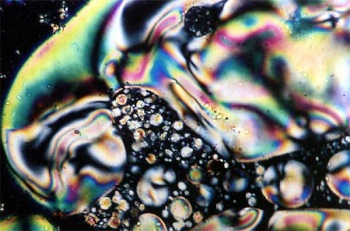A team of engineers at the University of Wisconsin-Madison has demonstrated a versatile fabrication method to use defects in liquid crystals as small tubing, which can be used to channel molecules into specific positions to create new nanostructures and materials.
 Liquid Crystal Structure,
Polimerek / Wikimedia Commons
Liquid Crystal Structure,
Polimerek / Wikimedia Commons
"By controlling the geometry of the system, we can send these channels from any one point to any other point," says Nicholas Abbott, a UW-Madison professor of chemical and biological engineering. "It's quite a versatile approach."
Abbott and his team at the Materials Research Science and Engineering Center (MRSEC) at University of Wisconsin, Madison, have so far been successful in assembling phospholipids within imperfections in liquid crystals. Phospholipids are molecules that are capable of arrange themselves into layers on the walls of living cells.
Their technique can be extended to assembling metallic wires and other semiconducting structures that are important in electronics. The selective abilities of a membrane can also be imitated through this approach, allowing for the design of a defect that allows only certain types of molecules to pass through, while preventing others.
"This is an enabling discovery," Abbott says. "We're not looking for a specific application, but we're showing a versatile method of fabrication that can lead to structures you can't make any other way."
Abbott has been studying the surfaces of soft materials, which included liquid crystals, for around two decades. Liquid crystals are a specific phase of matter wherein liquid-like materials show some of the molecular arrangement of solids.
"We've done a lot of work in the past at the interfaces of liquid crystals, but we're now looking inside the liquid crystal," he says. "We're looking at how to use the internal structure of liquid crystals to direct the organization of molecules. There's no prior example of using a defect in a liquid crystal to template molecular organization."
Varied defect types can be achieved by altering the geometry of liquid crystals. Abbott’s team assembled liquid crystals with imperfections in the form of ropes or lines - referred to as “disclinations” - which created templated that could be filled with water- and fat-loving molecules known as amphiphillic molecules.
Assemblies of molecules can be linked together after the removal of the liquid crystal templates, resulting in amphiphilic building blocks in the form of a permanent nanostructure.
The research is an example of how liquid crystal research is taking us from the nano to macro world, says Dan Finotello, program director at the National Science Foundation, which funds the MRSEC.
"It is also an exquisite demonstration of MRSEC programs' high impact," Finotello says. "MRSECs bring together several researchers of varied experience and complementary expertise who are then able to advance science at a considerably faster rate."
The research team consisted of Xiaoguang Wang, Daniel S. Miller and Emre Bukusoglu – graduate students from UW-Madison, and Juan J. de Pablo – former engineering professor at UW-Madison, currently at the University of Chicago.
The study results have appeared in the journal 'Nature Materials'.